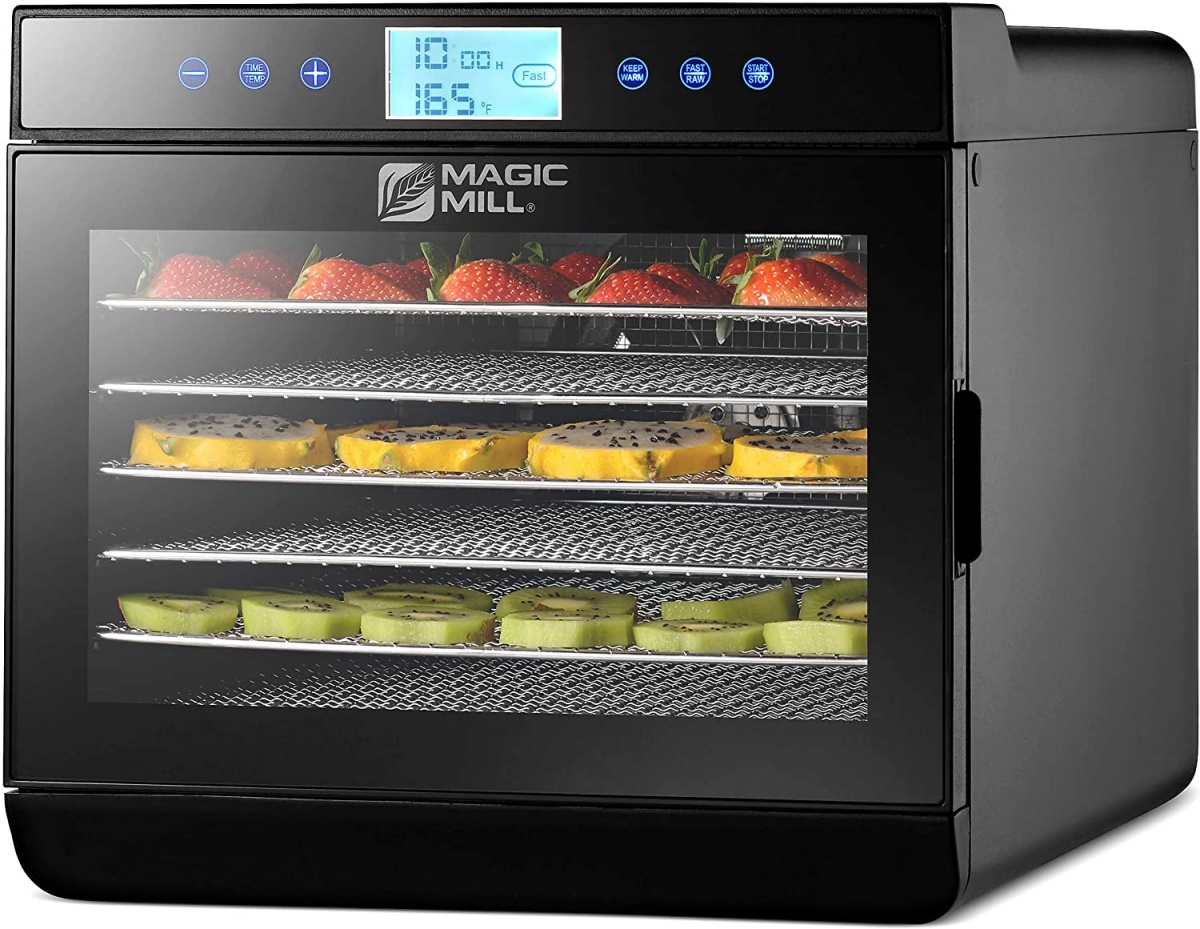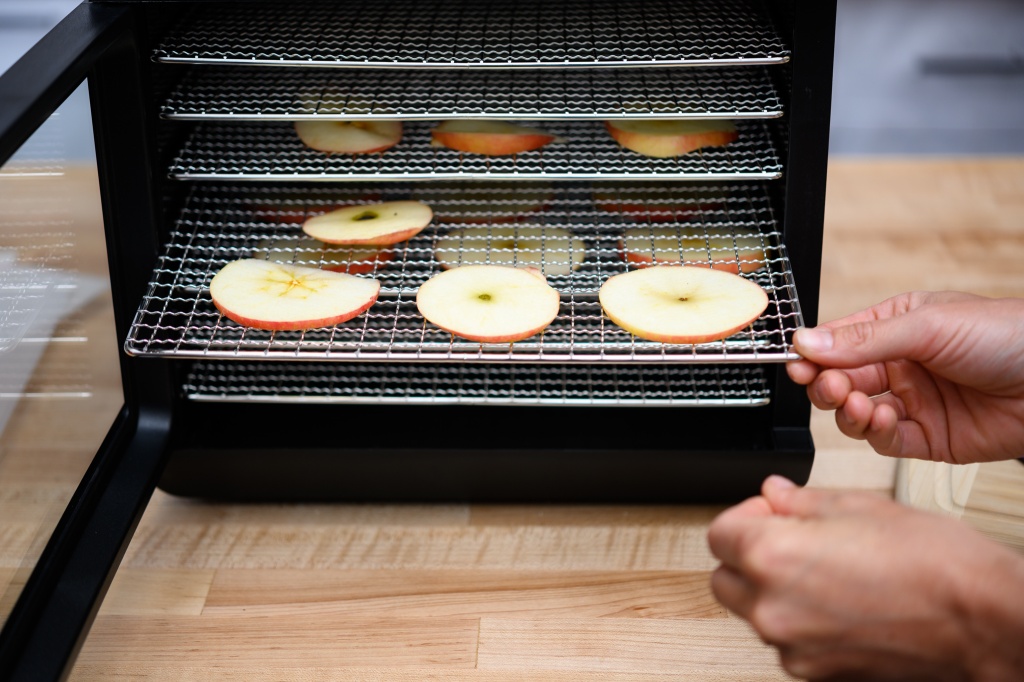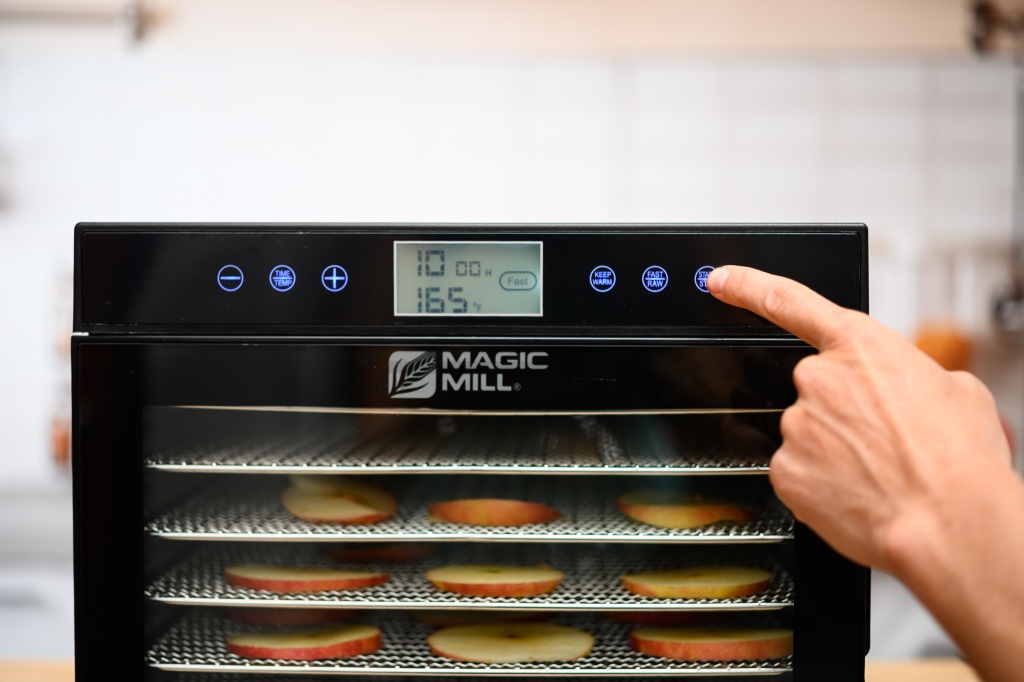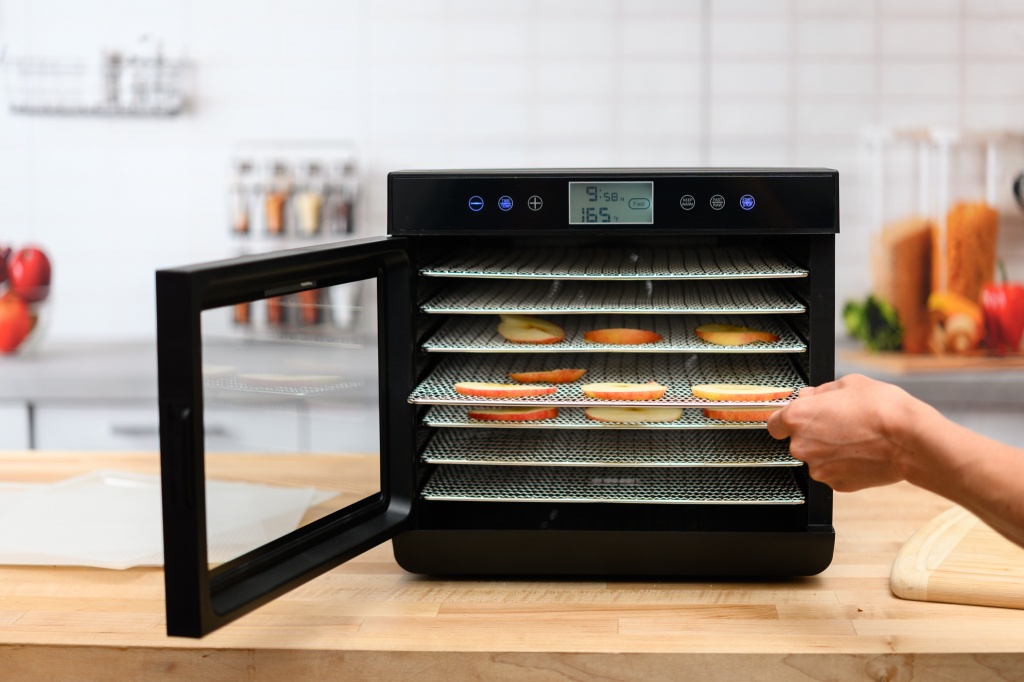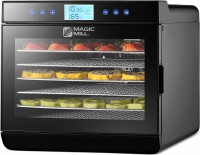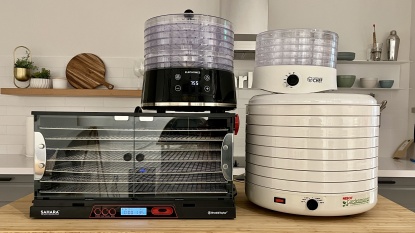Magic Mill Food Dehydrator Review

Our Verdict
Our Analysis and Test Results
Dehydrating
To begin our evaluation, we wanted to be sure that each model met our standards of what an acceptable finished snack should be. To get an all-encompassing glimpse of dehydration performance, we prepared several types of food with varying degrees of moisture content and density. We made jerky, dried herbs, fruit leather, and cherry tomatoes. We examined each variety of food for physical consistency to see if anything got too dry or remained undried. Lastly, we let the GearLab in-house team try the food and note their opinions if there was anything they really liked or especially did not like.
The Magic Mill is one of the top-scoring models for this portion of our assessment. For all four of our food types, this model's performance is spot-on. The fruit leather was done quickly with few lingering wet spots, and the herbs dried fast but didn't lose any of their flavors. Our panel of judges loved the way the tomatoes turned out, as they had concentrated flavor and a perfect texture. Finally, the jerky was top-notch. It was chewy but not overly tough, and although the marinade seemed to have evaporated entirely, the flavor remained with the meat.
Temperature Accuracy
It is imperative that kitchen appliances have accurate thermostats and controls. If cooking temperatures are off by a large enough amount, they can completely ruin a meal. Not only is this disappointing, but it's a waste of time, food, and ultimately money. If a user interface on an appliance such as a dehydrator displays the wrong temperature, you may be left scratching your head trying to figure out why things aren't turning out the way they're supposed to. To double-check the accuracy of these devices, we used a thermocouple sensor to compare measured temperatures to displayed temperatures on the dehydrators. The next 25% of our total score is dedicated to the results of this experiment.
The Magic Mill food dehydrator's temperature display is exceptionally accurate. At temperature settings of 100, 115, and 130 degrees, the display read the exact temperature that we measured with the thermocouple. It was only when we cranked the temperature setting up to 165 degrees that we saw any sort of deviation. At this setting, the thermocouple only showed an actual temperature of 155 degrees, so we were forced to reduce the Magic Mill's score for this metric.
Ease of Cleaning
Those of us who know our way around the kitchen know the daunting task of cleaning all too well. Although kitchen appliances often take a lot of the headache and guessing out of cooking, sometimes they seem to almost add more work than they're worth when it's time to clean up. If this sounds familiar, we would like to advise you to pay close attention to this section; few things are more frustrating than cooking the perfect treat, only to find out that you'll be spending more time cleaning than you did cooking and eating. For this metric, we looked at how difficult each device is to clean once the cooking is done.
The Magic Mill is about the middle of the road as far as scores go for the cleaning metric. The metal trays are easy to remove and are no problem to clean. The floor of the machine is smooth and easy to wipe out. The reason why the Magic Mill didn't score quite as high as some of the others for this metric really comes down to its overall design. Our team found that the easiest models to clean are those with bodies composed of stackable plastic trays that are able to be completely detached from the base and either scrubbed in the sink or thrown in the dishwasher. Also, many of the metal tray-style models include a plastic tray on the floor to catch crumbs and drips — the Magic Mill lacks this element. That said, this model's trays are the easiest to clean of all the metal versions that we've seen.
Ease of Use
For the final portion of our overall score, we subjectively judged how easy or difficult each food dehydrator is to use. Some of these devices have simple analog nobs and a design that keeps you guessing as far as temperatures go, and others have digital displays with buttons for controls. Some have a few basic settings, while others can be programmed to raise and lower the temperature in intervals. Depending on how involved you'd like to get in your dehydration process, you may want to put more weight on this metric before making a purchasing decision. We also compared the square footage of cooking area each model offers.
The Magic Mill is astonishingly easy to use. The digital user interface is large and easy to read. The settings include time, temperature, keep warm, and +/- buttons. The buttons illuminate, helping you to operate in both bright kitchens with glare and low-light kitchens. There is a “fast mode” that dries food at a higher temperature for less time and a “raw mode” that dries food at lower temperatures for a much longer time. The large glass door is great for observing your food throughout the dehydration process. With its seven one square foot trays, the Magic Mill has a total cooking area of seven square feet.
Value
Every once in a while, a product is priced just right. The Magic Mill falls into this category as it performs at the highest level; it's also easy to use, is built to last, and it looks good on a countertop to boot. So, while you're not getting a killer deal on this machine, you can rest assured that you are getting your money's worth.
Conclusion
The Magic Mill is a top-tier food dehydrator, pumping out high-quality dehydrated foods in a minimum amount of space. The modern digital interface is intuitive, the fan is quiet, the transparent door practical, and the metal tray easy to clean. We think that most home cooks will find this machine to be the right size at the right price. Hands down, the Magic Mill is the best mid-size dehydrator. This machine is built to impress, from its sharp-looking exterior to its durable trays to its easy-to-operate controls. Add a reasonable sticker price to these accolades, and you can be certain that this unit renders the best results with the least amount of fuss.
| Awards | Best Mid-Size Food Dehydrator |
|---|---|
| Price | $190 List Check Amazon (on sale!) |
Overall Score  |
|
| Star Rating | |
| Bottom Line | A modern-looking machine with intuitive controls, metal trays, consistent heat, and primo outcomes |
| Pros | Metal trays, easy clean-up, digital interface |
| Cons | Temperature settings in 10 minute increments, inaccurate on high heat settings |
| Rating Categories | Magic Mill |
| Dehydrating (25%) | |
| Temperature Accuracy (25%) | |
| Ease of Cleaning (25%) | |
| Ease of Use (25%) | |
| Specifications | Magic Mill |
| Tray Dimensions | 13" x 12" |
| Number of Trays | 7 |
| Temperature Range | 95-165 F |
| Tray Material | Stainless steel |
| Power Consumption | 480W |
| Capacity | 7.6 sq ft |
| Outside Dimensions | 18" x 14" x 13" |


